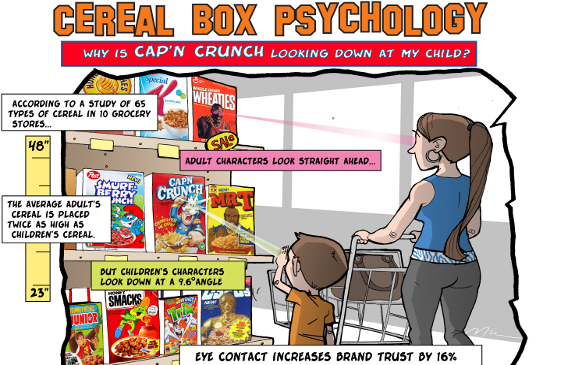Why Cap’n Crunch is Staring At Your Kid
Why Cap’n Crunch is Staring At Your Kid
Food makers spend millions in marketing, fine tuning their sales methods to make the most money.

The research didn’t only discoverthat cereal mascots are designed to look directly at you, but that the angle of their eyes depends on their intended market. The athlete on the Wheaties box will look straight ahead, to catch your eyes, while the cartoon figures on the unhealthiest children’s cereals will actually look down at an angle of about 9.67 degrees, calibrated specifically to look directly into the eyes of children.
As with most marketing techniques, this one isn’t some random shot in the dark; it is used because it works.
Cornell researchers showeddifferent Trix cereal boxes to 63 college students (who, as we know, sometimes live off breakfast cereal). One of the boxes featured a rabbit that made eye contact and the other a rabbit that looked away. Brand trust was 16% higher in the rabbit who made eye contact. Further, college students felt “connection” to the brand at a 10% higher rate with the bunny who looked straight at them.
Read: 10 Terrible Children’s Cereals to Avoid
It’s a well-known human phenomenon to trust people who are willing to look you in the eyes. But this study indicates our preference for eye contact extends to fictional characters printed on boxes as well.
The study focused on 65 different cereals and 86 different characters in 10 different grocery stores. Product placement for greatest appeal was obviously discovered—where children’s cereals are placed lower on the shelves where kids can see them better. But adding to this almost-predatory marketing technique was the leering stares of cereal mascots, scanning the smallest customers for a bit of eye contact and a potential sale.
“If you are a cereal company looking to market healthy cereals to kids, use spokes-characters that make eye contact with children to create brand loyalty,” said lead researcher Brian Wansink with some valuable take-aways. “If you are a parent who does not want your kids to go ‘cuckoo for Cocoa Puffs,’ avoid taking them down the cereal aisle.”
Other Popular Stories:
Get The NaturalSociety Natural Health Newsletter!

Post a Comment